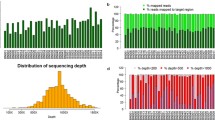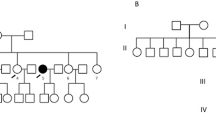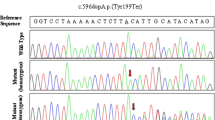Abstract
Linkage studies have identified susceptibility loci for familial nonmedullary thyroid cancer (FNMTC), with and without cell oxyphilia, at chromosomal regions 19p13.2 and 2q21. There are few genetic analyses of FNMTC tumours reported at the present time and the eventual gene involved was not identified yet. The aim of this study was to assess the occurrence of loss of heterozygosity (LOH) at these loci in the tumours from familial clusters of NMTC. We have analysed LOH in 14 tumours from 9 two-case familial clusters of NMTC. Using paired blood (normal) and tumour DNA samples, we have genotyped ten microsatellite and one SNP markers throughout 19p13.2 and fourteen microsatellite markers at 2q21. Overall, eight (57%) and two (14%) out of the fourteen tumours analysed exhibited LOH at 19p13.2 and 2q21, respectively. In two families (22%), LOH for the same markers was demonstrable in the tumours of the two members of the same family. In one family (11%) LOH was demonstrable at both loci analysed. In four two-case familial clusters (44%), LOH at the 19p13.2 locus was found in only one of the tumour cases analysed. Detailed haplotype analysis showed that, in two families (22%), the pattern of LOH in tumours was consistent with selective retention of the haplotype shared by affected members. In the remaining cases, it was consistent with random allelic losses. In conclusion, we report the finding of LOH at the 19p13.2 and 2q21 loci in tumours from familial clusters of NMTC, providing evidence that inactivation of putative genes in these regions, acting as tumour-suppressors, may be involved in the development of tumours in the context of FNMTC.



Similar content being viewed by others
Abbreviations
- BL:
-
BiLateral
- CO:
-
Cell Oxyphilia
- FA:
-
Follicular Adenoma
- FFPE:
-
Formalin Fixed Paraffin Embedded Tissue
- FNMTC:
-
Familial Non-Medullary Thyroid Carcinoma
- FTC:
-
Follicular Thyroid Carcinoma
- FV:
-
Follicular Variant of Papillary Thyroid Carcinoma
- LOH:
-
Loss-of-heterozygosity
- MF:
-
MultiFocal
- MNG:
-
MultiNodular Goitre
- N:
-
Normal DNA
- NMTC:
-
Non-Medullary Thyroid Carcinoma
- PBL:
-
Peripheral Blood Leukocyte
- PTC:
-
Papillary Thyroid Carcinoma
- SNP:
-
Single Nucleotide Polymorphism
- SSCP:
-
Single Strand Conformation Polymorphism
- T:
-
Tumour DNA
- WLV:
-
Warthin-Like Variant
References
Schlumberger MJ (1998) Papillary and follicular thyroid carcinoma. N Engl J Med 338:297–306
Stoffer SS, Van Dyke DL, Bach JV et al (1986) Familial papillary carcinoma of the thyroid. Am J Med Genet 25:775–782
Malchoff CD, Malchoff DM (2006) Familial nonmedullary thyroid carcinoma. Cancer Control 13:106–110
Grossman RF, Tu SH, Duh QY, et al (1995) Familial nonmedullary thyroid cancer: an emerging entity that warrants aggressive treatment. Arch Surg 130:892–897
Houlston RS, Stratton MR (1995) Genetics of non-medullary thyroid cancer. Q J Med 88:685–693
Malchoff CD, Malchoff DM (1999) Familial nonmedullary thyroid carcinoma. Semin Surg Oncol 16:16–18
Burgess JR, Duffield A, Wilkinson SJ et al (1997) Two families with an autossomal dominant inheritance pattern for papillary carcinoma of the thyroid. J Clin Endocrinol Metabol 82:345–348
Hemminki K, Dong C (2000) Familial relationships in thyroid cancer by histopathological subtype. Int J Cancer 85:201–205
Pal T, Vogl FD, Chappuis PO et al (2001) Increased risk for nonmedullary thyroid cancer in the first degree relatives of prevalent cases of nonmedullary thyroid cancer: a hospital-based study. J Clin Endocrinol Metabol 86:5307–5312
Frich L, Glattre E, Akslen LA (2001) Familial occurrence of nonmedullary thyroid cancer: a population-based study of 5673 first-degree relatives of thyroid cancer patients from Norway. Cancer Epidemiol Biomarkers Prev 10:113–117
Hemminki K, Eng C, Chen B (2005) Familial risks for non-medullary thyroid cancer. J Clin Endocrinol Metabol 90:5747–5753
Alsanea O, Wada N, Ain K et al (2000) Is familial non-medullary thyroid carcinoma more aggressive than sporadic thyroid cancer? A multicenter series. Surgery 128:1043–1050
Uchino S, Noguchi S, Kawamoto H et al (2002) Familial nonmedullary thyroid carcinoma characterized by multifocality and a high recurrence rate in a large study population. World J Surg 26:897–902
Bignell GR, Canzian F, Shayeghi M et al (1997) Familial nontoxic multinodular goiter locus maps to chromosome 14q but does not account for familial nonmedullary thyroid cancer. Am J Hum Genet 61:1123–1130
Canzian F, Amati P, Harach HR, et al (1998) A gene predisposing to familial thyroid tumors with cell oxyphilia maps to chromomosome 19p132. Am J Hum Genet 63:1743–1748
Malchoff CD, Sarfarazi M, Tendler B et al (2000) Papillary thyroid carcinoma associated with papillary renal neoplasia: genetic linkage analysis of a distinct heritable tumor syndrome. J Clin Endocrinol Metabol 85:1758–1764
McKay JD, Lesueur F, Jonard L et al (2001) Localization of a susceptibility gene for familial nonmedullary thyroid carcinoma to chromosome 2q21. Am J Hum Genet 69:440–446
Bevan S, Pal T, Greenberg CR et al (2001) A comprehensive analysis of MNG1, TCO1, fPTC, PTEN, TSHR, and TRKA in familial nonmedullary thyroid cancer: confirmation of linkage to TCO1. J Clin Endocrinol Metabol 86:3701–3704
McKay JD, Thompson D, Lesueur F et al (2004) Evidence for interaction between the TCO and NMTC1 loci in familial non-medullary thyroid cancer. J Med Genet 41:407–412
Bonora E, Evangelisti C, Bonichon F et al (2006) Novel germline variants identified in the inner mitochondrial membrane transporter TIMM44 and their role in predisposition to oncocytic thyroid carcinomas. Br J Cancer 11:1529–1536
Musholt TJ, Musholt PB, Petrich T et al (2000) Familial papillary thyroid carcinoma: genetics, criteria for diagnosis, clinical features, and surgical treatment. World J Surg 24:1409–1417
Vasen HF, Mecklin JP, Khan PM, Lynch HT (1991) The International Collaborative Group on Hereditary Non-Polyposis Colorectal Cancer (ICG-HNPCC). Dis Colon Rectum 34:424–425
Caldas C, Carneiro F, Lynch HT et al (1999) Familial gastric cancer: overview and guidelines for management. J Med Genet 36:873–880
Stankov K, Pastore A, Toschi L et al (2004) Allelic loss at chromosomes 2q21 and 19p13.2 in oxyphilic thyroid tumours. Int J Cancer 111:463–467
Charkes ND (2006) On the prevalence of familial nonmedullary thyroid cancer in multiply affected kindreds. Thyroid 16:181–186
Acknowledgments
We acknowledge the financial support for this work by grants awarded by the “Edward Limbert Prize for Thyroid Pathology” of the Portuguese Society of Endocrinology Diabetes and Metabolism (SPEDM), and the funding from the Portuguese Ministry of Health (“Comissão de Fomento da Investigação em Cuidados de Saúde”). We thank all patients and family members that have participated in this study. We thank Dr. Maria Madalena Barroso, MD and Dr. Leonor Gomes, MD (University Hospitals of Coimbra), Dr. Lígia Prado e Castro, MD (Hospital Centre of Coimbra) and Dr. Teresa Carvalho, MD (Hospital of Viseu) for providing FFPE tissue and clinical information on some of the patients included in this study.
Author information
Authors and Affiliations
Corresponding author
Rights and permissions
About this article
Cite this article
Prazeres, H.J., Rodrigues, F., Soares, P. et al. Loss of heterozygosity at 19p13.2 and 2q21 in tumours from familial clusters of non-medullary thyroid carcinoma. Familial Cancer 7, 141–149 (2008). https://doi.org/10.1007/s10689-007-9160-x
Received:
Accepted:
Published:
Issue Date:
DOI: https://doi.org/10.1007/s10689-007-9160-x




